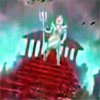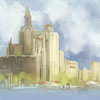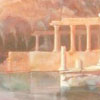The Rise And Fall Of Atlantis
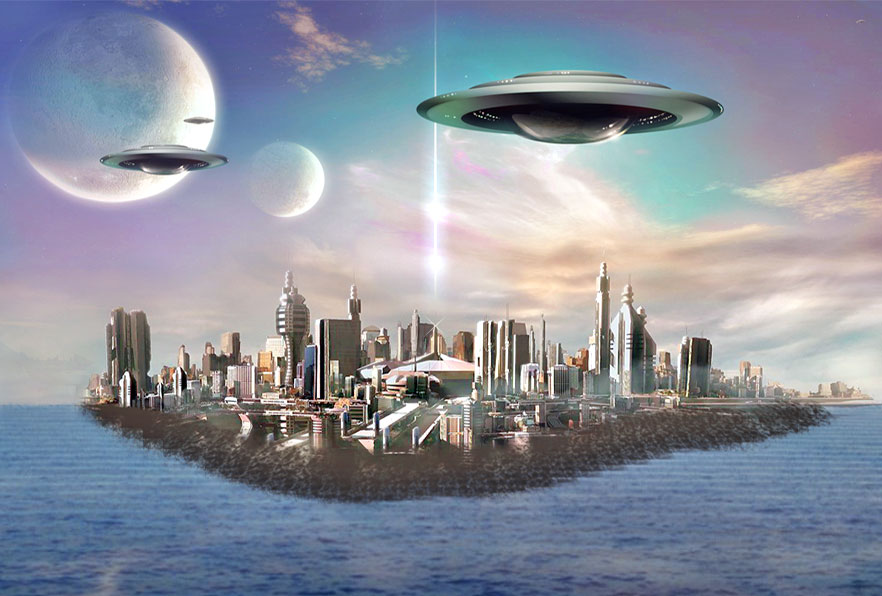 by Edgar Cayce (edited by Lytle Robinson)
by Edgar Cayce (edited by Lytle Robinson)
Ever since Plato wrote his startling account of a sunken continent, men have debated the reality of its existence. Indeed, no historical subject has produced more controversy and been of such persistent duration. Long since lost in antiquity, here is a land and a people about which history officially knows nothing. In spite of Plato’s story and some 25,000 volumes subsequently written on the subject, only the bravest of modern scholars give any credence to the Atlantean theory.
The first recorded mention of such a land is in Plato’s Timaeus, written in the fifth century before Christ. Here the great philosopher describes a conversation between certain Egyptian priests and Solon, an Athenian statesman of the seventh century B.C. The priests represented Atlantis as a great island larger than Asia Minor and Libya combined, lying just beyond the Straits of Gibraltar. It had been a powerful kingdom 9,000 years before the birth of Solon, in 638 B.C., and its invading hordes had overrun the lands which bordered the Mediterranean.
Only Athens itself had successfully withstood the Atlantean invasions. Finally, because of the wickedness of its inhabitants, earthquakes and the sea overwhelmed Atlantis and it disappeared into the ocean. In the unfinished Critias, Plato adds a history of the ideal commonwealth of Atlantis—the political Utopia of another age.
Pliny, the Roman naturalist, also discusses it in his Natural History, a sort of encyclopedia written in the first century A.D. Early Arabian geographers place Atlantis on their maps. Medieval writers accepted it as true history, and their beliefs were substantiated by numerous traditions of ancient islands in the eastern seas which offered various points of resemblance to Atlantis. Some of these sunken islands were marked on maps as late as the sixteenth century A.D.
There are traditions of a great flood among almost all races of ancient peoples, indicating a common origin and a widespread acceptance of the legend. In the seventeenth and eighteenth centuries the subject of Atlantis was still seriously debated, and its credibility admitted by such men as Voltaire, Montaigne, and Buffon. Francis Bacon, in his allegory, The New Atlantis, published in 1627, presents it as a symbolic Utopia established on scientific principles; a high cultivation of natural science and the arts.
Many attempts have since been made to rationalize the story of Atlantis, the best perhaps being Atlantis: The Antediluvian World, by Ignatius Donnelly. The land has variously been identified with America, the Scandinavian countries, the Canary Islands, and Palestine—but usually with the main body of it lying in the North Atlantic.
Perhaps its most most prominent defender of modern times was Edward H. Thompson, archaeologist and American Consul for twenty-four years to Yucatan, Mexico. He died in 1935, still convinced that the mysterious tribe of Mayan Indians of Central America was originally from Atlantis. A few others have held to this view despite the ridicule of the conservative element of science.
Scholars have long tended to regard the whole story as invention, since no contemporary written records have been found. Little credence is given to the early accounts, the legends or the theory, although the latter does answer many otherwise unanswered questions. Plato, Pliny and Bacon are not known as writers of pointless fiction, and the story as a myth would appear to be grossly out of place in serious philosophic and historic works. Why they should now be accused of fabricating their accounts, except partially in the case of Bacon, is as regrettable as it is unrealistic and unlikely.
Geologists have discovered that the coastline of western Europe at one time extended farther in the direction of America than it does now, and that its submergence must have taken place long before history was recorded. There are known mountain ranges, ravines and ridges in the bottom of the Atlantic. Because of a broken cable running between Brest, France and Cape Cod, geologists found lava which proved to have hardened under atmospheric conditions—and therefore above water—less than 15,000 years ago. In Colorado an ancient dog’s skull of European origin was identified as that of a species 12 to 15 million years old, suggesting a land bridge to that continent.
Archaeological findings reveal striking similarities between ancient Egyptian and Central American architecture, art and inscriptions, although the two lands are separated by thousands of miles of ocean. Atlantean migration to both areas is a plausible answer, especially since no other satisfactory solution to the problem has been put forth.
Atlantis is first mentioned in the Cayce Records in a reading given in 1923. After that, many facets of its history appear hundreds of times in readings for different persons over a period of twenty-three years. The readings not only corroborate its existence and the best that has been written on the subject, but they supply much that is new and give a detailed and comprehensive picture of the land and its peoples. More than that, and perhaps most important of all, they relate its amazing civilization to our present age in a way that is stirring, convincing, and alarming.
Interwoven in the last era of the Atlantean culture are factors that have direct and significant influences on the problems of current events at home and abroad. These are not by accident; and the numerous parallels between the two civilizations drive home the crucial importance of the decisions America now faces.
From The Cayce Records
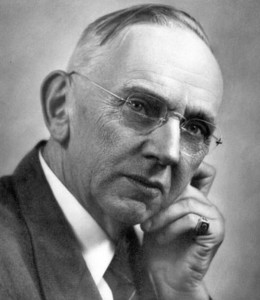 When man entered the earth as a physical being, the land areas of the world were very different from what they are today. After the shift of the poles and the breaking up of the continents many thousands of years later, vast changes were to take place.
When man entered the earth as a physical being, the land areas of the world were very different from what they are today. After the shift of the poles and the breaking up of the continents many thousands of years later, vast changes were to take place.
The polar regions were then tropical and semi-tropical. Most of the North American continent was covered with water except for the states of Utah, Nevada, Arizona and New Mexico. These were fertile plains, as was the Gobi Desert of East Asia. The Andean coastal area of South America was under water, as was most of that continent except the region of the Southern cordilleras and Peru. The upper part of West Africa—Egypt and the Sudan—was above water, and the Nile emptied into the Atlantic Ocean. In Europe and Asia, the regions of the Carpathian and Caucasian Mountains, Norway, Mongolia and Tibet were above sea level. Iran and the Caucasus were rich lands—the Garden of Eden.
The continents of Lemuria and Atlantis were the world’s largest land areas. Lemuria, lying roughly in what was later to become the Pacific Ocean, extended from the western part of the United States to South America. The Andean coast was its tideland area, as were portions of Central America.
Atlantis, occupying largely what was later to be the North Atlantic Ocean, was the most important land area. It compared in size to Europe and Russia combined. The eastern seaboard of the United States, then mostly under water, comprised the coastal lowlands of Atlantis, which extended to the Gulf of Mexico and as far as to the Mediterranean Sea. The island of Bimini off the coast of Florida was a part of the continent, as were the Bahamas in the British West Indies and Yucatan in southern Mexico.
When the perfect race appeared in Atlantis in what was known as the red race, the land was already inhabited by the monstrosities. These were the soul-entities who had taken on all sorts of strange and grotesque bodies in order to experience material existence on the earth. They had existed for hundreds of thousands of years and, as in the rest of the world, had become all shapes and sizes, from pygmies to giants twelve feet tall—with many freakish abnormalities resulting from their mixing with the animals.
At first they lived peacefully together, for the struggle of the Sons of God to be fruitful, multiply and replenish the earth and subdue it did not at once meet active, organized resistance. Souls born with perfect bodies continued to enter the earth in large numbers to help keep the balance and prepare for the dissensions that later were to come with the Sons of Belial—those of both races who turned away more and more from the divine will. But with this second influx of souls, some ten and a half million years ago, even in that day did they call upon the name of the Lord.
Swiftly they banded together in a family and clan life. They ate the herbs and fruit of the now flowering earth, and for clothing wore the skins of animals to cover that portion of the body which had already brought such destructive influences in their sex relations with the monstrosities. They lived in rocks, in caves, and in trees. Motivated by the desire to excel, to control, to dominate, households, clans and then tribes came into existence, accelerated by the search for companionship, protection and trade. Quickly they learned that their well-being was dependent upon each other.
The people of Atlantis were to pass through the same stages of development as the other four races in the various lands, although their progress was to be more rapid. Unlike the rest of the world, the Atlanteans as a nation were a peaceful people at this time and more readily made use of the laws of nature.
Stone was first utilized in implements to secure food and protect themselves from the animals. At an early period houses of wood, then of stone, circular in shape, were built. First the Atlanteans were hunters; then herders and farmers, using tools of stone and wood. Fire and natural gas were among the first discoveries; iron and copper quickly followed. Soon they were fabricating balloons from the hides of elephants and other large animals and using them for the moving of building materials. Communities and communication slowly came into existence.
The monstrosities and the mixtures, hampered by cumbersome bodies and dull minds, made almost no material progress at all, except for that passed on to them by their masters. Physically, over the centuries, they gradually began to lose some of their animal appearance and instinct, through intermarriage and repeated reincarnation in the earth.
But the real problem was with the animal kingdom. Enormous, carnivorous beasts roamed the forests of the mountains and the jungles of the valleys. Giant fowls hovered above the earth, feeding upon and devouring whatever was at hand. Physically inept in comparison, man had but one superior weapon of defense: the soul-force, or mind. By exercising the power of will and reason, he was able to devise, to improvise, to outwit. By this means alone was he able to survive the brute strength of the animals, whose rule was the Survival of the Fittest.
Still relatively close to God although he had fallen into matter, man during his first thousand years on earth was possessed of a body through which the soul expressed itself much more easily than later was to be the case. Occult powers were commonplace. The third eye, or pituitary gland, located near the center of the forehead, was highly developed. Through this gland functioned the creative psychic abilities of the soul. Those of the perfect race thereby had knowledge of happenings in distant places and foreknowledge of events to come. They also had the power to control the monstrosities and subject them to their will. Yet man was continually drifting away from his source and submerging more, and more into the material world with all its temporal interests; thus he was eventually to lose—for all practical purposes—this God-given power. These gifts of the spirit would remain submerged until men had again spiritualized themselves in thought and deed. Few were able to do so.
The animal kingdom became an increasing problem, and the constant threat of death made life miserable. A council of the wise men of five nations of the world, representing the five races, was called around 52,000 B.C. Representatives came from the white race in the Caucasus, the Carpathian Mountains of Central Europe, and Persia; from the yellow race in what later became the Gobi desert; the black race in the Sudan and upper West Africa; and the brown race in Lemuria. In the first meeting for united action, ways and means were planned for combating the creatures overrunning the earth in so many places. Discussions for defense centered around the use of the potent chemical forces in the elements of the earth and air. The decisions made proved to be effective, but they had unexpected and far-reaching consequences during the years ahead.
The mixtures and monstrosities were the outcasts of society. Frequently of low principle and little self-will or control, they were used for the most menial tasks. Their status in the social scale was little higher than that of domesticated animals and beasts of burden. Because of them men of the perfect race fell into two camps, bitterly opposed to each other in ideology. It was the mixing of those of pure lineage with those who had not completely overcome the animal influences that brought dissensions and the rise of strife and turmoil.
These outcasts, enslaved by those of Belial, the followers of Baal or Beelzebub—the forces of evil—were treated very harshly. Through the use of occult powers, hypnosis and mental telepathy, they were under complete domination of their masters. They were bred like cattle for particular types of work and enjoyed none of the fruits of their labor and very little home life. Commonly known as Things—the untouchables, the automations—they did all the work in the fields, the households, and some of the trades.
Castes and classes came into being, fostered by the Sons of Belial through greed, contempt and hatred. Bloodshed resulted from this disregard of and disrespect for the rights and freedom of others. The many were subjected to the whims of the few for their own self-aggrandizement.
The laws of heredity and environment gradually became more of an influence; appearances changed according to the purity of the strain and individual purposes—ideals and motives of activity. There were some who were almost perfect in figure and feature; and others who had monstrous combinations of human physiques and animal appendages, such as hooves, claws, feathers, wings and tails. It was these strange creatures who later were to be so mysteriously depicted in Egyptian and Assyrian inscriptions At an early period in Egypt they were finally to disappear from the human race.
These daughters of men and giants in the earth of the Old Testament were the reason for the admonishment: Keep the race pure. Yet the mixtures sometimes produced divine bodies with twisted, warped souls; or repulsive bodies with souls seeking the light. It was not the body that mattered so much, but the purity of purpose, of ideals.
Through the injunction, If you will be my people I will be your God, an effort was made by the more spiritual-minded to draw people to the worship of the One God. Known as the Children of the Law of One, they sought to purify the race in purpose as well as in body. The tenets of those of the Law of One—One Religion, One State, One Wife, One Home, One God—had little appeal to the Sons of Belial.
The first altars were established for the sacrifice of the fruits of man’s labors; the harvest of the fields and the flocks of the pastures. Religion came into being, motivated by what man felt but no longer knew to be true, although the Law of One has always been the same:
“Love ye in your daily experience. Apply in your daily activities the love that ye would have the Father show ye. In your relationships to your fellow man, do ye know the Law of One.”
That was the first creed, established upon the first law of God to His children: Hear, O Israel (seekers) the Lord thy God is One. Thou shalt have no other gods before Me.
Temples were established and soon the symbols of religion—ceremonies, rituals, prayers and chants—were instituted. The sacred fires were started as the shrine of the pure and the means of cleansing and spiritualizing the mixtures who came seeking enlightenment and a more divine purpose in their lives. Religion was slowly developing as a system—a method of reminding man of his divinity. The continuity of life, or reincarnation, was recognized as an essential part of the plan of evolution for the soul. Karma, the law of cause and effect in action, or As ye sow, so shall ye reap, was fundamental.
Thus the breach between those of the Law of One and those of Belial slowly took form, a breach that later was to widen into a gulf. The carnal, materialistic way of life of the followers of Belial was attractive even to many of the Children of the Law of One, and numbers of them succumbed to the temptations. With the emphasis on the value of temporal things and the de-emphasis on the spiritual, idol worship crept into the religious scene.
The first of the series of three continental catastrophes occurred many thousands of years before the final drowning. It came as a material result of the use of chemicals and high explosives in the plan to annihilate the wild beasts. The real reason was the low state into which man had fallen.
Huge and numerous gas pockets were blown open in the lairs of the animals, precipitating volcanic eruptions and earthquakes in the still slowly cooling earth. The magnitude of the disturbances caused the axis of the world to shift, bringing the poles to their present position and producing the last of the great Ice Ages.
Lemuria was the first to be affected, losing much of its territory as it began to sink into the Pacific. In Atlantis, the area of the Sargasso Sea, off the west coast of Cuba, was the first to go under water. The rest of the continent was broken up into several large islands with many canals, ravines, gulfs, bays and streams. The temperate climate rapidly changed to a more torrid one.
With the upheavals, the initial migrations from Atlantis took place in small numbers to the east and west. The earliest settlements were in the region of the Pyrenees Mountains in France and Spain; then later in Central and South America. The movement of the Lemurians was primarily to South America. The land of Og, along the Pacific coastal area of what was later to be southern Peru, was occupied. This was the beginning of that mysterious tribe of Indians known as the Incas.
Excerpt from Story Of The Origin And Destiny Of Man
See Part II here.
Posted in Atlantis, True History of Manwith comments disabled.


